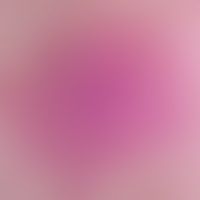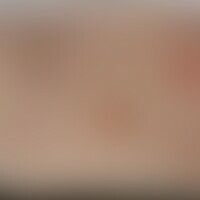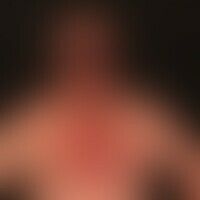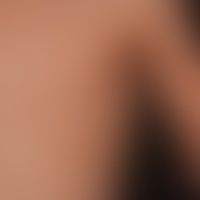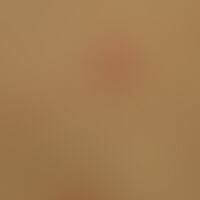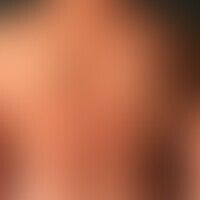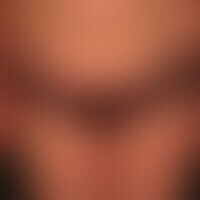Image diagnoses for "Torso", "Plaque (raised surface > 1cm)"
269 results with 958 images
Results forTorsoPlaque (raised surface > 1cm)

Naevus melanocytic common D22.-
Nevus melanocytic more common: sharp border of the melanocytic nevus to the colored inked deposition border (here blue)

Becker's nevus D22.5
Becker-Naevus: During puberty and postpubertal increasing hairiness of a nevus previously only visible as a brown spot. No symptoms.
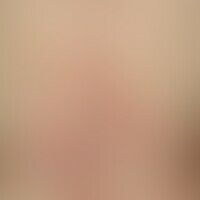
Nummular dermatitis L30.0
Nummular Dermatitis: General view: One year ago, for the first time, massive itching, initially papular, later plaque-shaped skin changes on the entire integument with emphasis on the extremities, trunk and buttocks of a 77-year-old woman.
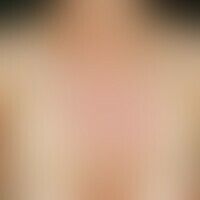
Rem syndrome L98.5
REM-syndrome. 1.5-year-old female patient with a reticular to planar, frayed, light red, temporarily itchy, urticarial erythema, papules and plaques in the décolleté area. The red colouring of the lesion is alternately strong and shows a clear deterioration after sun exposure.
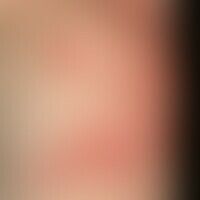
Contact dermatitis allergic L23.0
Contact dermatitis allergic: Acutely appeared, large red spots and plaques with rough, partly scaly surface as well as haemorrhagic vesicles in an 18-month-old boy. The skin changes occurred a few hours after extensive application of a cream containing lidocaine.
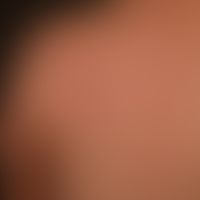
Pseudolymphomas of the skin (overview) L98.8
Pseudolymphoma of the skin: non-itchy, surface-smooth, reddish-brown papules and plaques on the left shoulder blade region; histological: non-clonal lympho-reticular proliferation, without epidermotropy.

Darian sign
Urticaria pigmentosa of childhood: extensive redness and urticarial reaction in the lesions after mechanical irritation.

Maculopapular cutaneous mastocytosis Q82.2
Urticaria pigmentosa:multiple, chronically stationary, known for 1 year, no longer increasing for 3 months, mainly localised on the trunk, 0.2-0.4 cm in size, blurred, red to reddish-brownish, smooth spots. no spontaneous itching. after warm bathing, the spots are bright red, eleated and itchy (wheals). lively redness and wheals appear even after mechanical irritation.
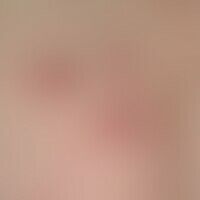
Nummular dermatitis L30.0
Nummular dermatitis: Detail enlargement : Massive itching, solitary or confluent, scratched, red lumps and plaques on the buttocks of a 77-year-old woman.
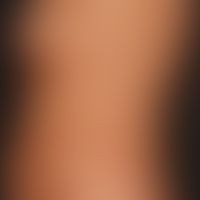
Circumscribed scleroderma L94.0
scleroderma circumscribed (plaque-type). 46 years old patient. 10 years old clinical picture. extensive firmly indurated brown plaques on the trunk. "risen" pattern. smooth atrophic, mirror-like surface.
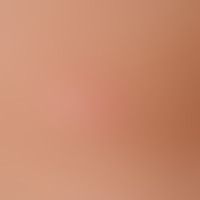
Pityriasis rosea L42
Pityriasis rosea. truncated, díchtes maculopapular exanthema arranged in the cleft lines, low itching. primary medallion.
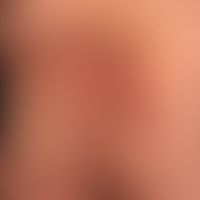
Suppurative hidradenitis L73.2
Hidradenitis suppurativa, a progressive and extensive finding with papules, pustules, nodules and indurated ductal fistulae that has been present for many years.
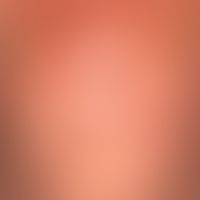
Transitory acantholytic dermatosis L11.1
Transitory acantholytic dermatosis (M.Grover): a few weeks old, only moderately pruritic clinical picture with disseminated papules and also papulo vesicles; Nikolski phenomenon negative.
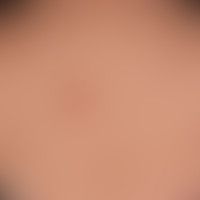
Sarcoidosis of the skin D86.3
Sarcoidosis plaque form: Symptomless, 5.0 cm large, coarse lamellar scaling plaque that has existed for several years.
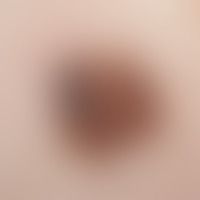
Keratosis seborrhoic (plaque type)
Keratosis seborrheic (plaque type): Flat irregularly bordered pigmented plaque.
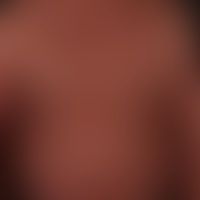
Poikilodermia vascularis atrophicans L94.5
Poikilodermia vascularis atrophicans: 72-year-old patient with a slowly progressive, varicolored-checked clinical picture of the skin, which has been present for > 15 years. the varicolored-checked skin is caused by reticular or stripe-shaped erythema and plaques. reticular or flat brown discoloration (hyperpigmentation) is also found. present is a "poikilodermatic mycosis fungoides".

Naevus melanocytic common D22.-
Nevus melanocytic more common: junctional and dermal melanocytic cell nests, superficially epitheloid and differently pigmented.
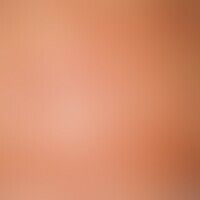
Pregnancy dermatosis polymorphic O26.4
PEP. Severe itching, red papules on the trunk of a 26-year-old pregnant woman in the 3rd trimester.
